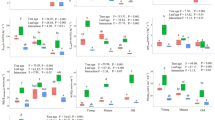Abstract
Previous studies analyzed the importance of old leaves conservancy for wintergreen species plant growth only after early spring old leaves elimination. However, carbon and nutrient resources for growth could have already been translocated from old leaves to shoots during autumn. In this work, the effect of old leaves absence on the leaf mass per area (LMA, g m−2) and nutrient concentration of new spring leaves, shoot growth, and flowering was studied in Aristotelia chilensis, an Andean Patagonic woody wintergreen species of Argentina. Plants were studied after autumn defoliation (AD) or late winter defoliation (WD) and results were compared to those of undamaged control plants (CO). The new leaves LMA and mineral nutrient (N, P, K, and Mg) concentration values did not decrease in AD or WD compared to CO plants. Conversely, CO plants showed higher flowering intensity and shoot lengthening compared to AD or WD plants. There were not remarkable differences regarding the defoliation time, though non-flowering shoots grew in a lesser degree than the flowering shoots in WD plants. It was concluded that A. chilensis old leaves cohort is an important source to shoot growth and flowering but their absence does not affect the new leaves structure or nutritional status from early spring in either AD or in WD plants. New leaves formation probably is guaranteed by resources (carbon and nutrients) previously stored in stems or even in the buds containing the preformed leaves since March, by the end of summer. Provided the availability of complete resources for the new leaf flush independently of the old leaves A. chilensis would restore the carbon balance as soon as possible to resume the growth of heterotrophic tissues at normal rates. Endogenous response to counterbalance the old leaves absence on non-flowering shoots was more effective when there was greater lag time between defoliation and shoot growth resume. Flowering and non-flowering shoots compete for the available resources when A. chilensis have not yet expanded leaves and shoots supporting reproductive structures were stronger sinks compared to non-flowering shoots in WD plants.
Similar content being viewed by others
References
O.C. Bataglia A.M.C. Furlani J.P.F. Teixeira P.R. Furlani J.R. Gallo (1983) Métodos de análise química de plantas Campinas Instituto Agronômico de Campinas (IAC), Boletim Técnico número 48
K.L. Bell L.C. Bliss (1977) ArticleTitleOverwinter phenology of plants in a polar semidesert Arctic 30 118–121
B.F. Chabot D.J. Hicks (1982) ArticleTitleThe ecology of leaf life spans Annu. Rev. Ecol. Syst. 13 229–259 Occurrence Handle10.1146/annurev.es.13.110182.001305
M.A. Damascos (1998) ArticleTitleTendencias morfológicas de las plantas de los claros y áreas sombreadas del bosque de Austrocedrus chilensisArgentina Ecología Austral 8 13–22
M.A. Damascos C.H.B.A. Prado (2001a) ArticleTitleDefoliación en la especie invierno-verde Aristotelia chilensis y su efecto sobre el crecimiento inicial de hojas y ramas Bosque (Chile) 22 IssueID(1 45–50
M.A. Damascos C.H.B.A. Prado (2001b) ArticleTitleLeaf phenology and its associated traits in the wintergreen species Aristotelia chilensis (Mol.) Stuntz (Elaeocarpaceae) Revista Chilena de Historia Natural 74 805–815 Occurrence Handle10.4067/S0716-078X2001000400008
R.E. Dickinson (1991) Assimilate distribution and storage A.S. Raghavendra (Eds) Physiology of Trees Wiley New York 51–85
S. Jonasson (1989) ArticleTitleImplications of leaf longevity, leaf nutrient resorption and traslocation for the resource economy of five evergreen species Oikos 56 121–131
S. Jonasson (1995) ArticleTitleResource allocation in relation to leaf retention time of the wintergreen Rhododendron lapponicum Ecology 76 475–485
P.S. Karlsson (1994) ArticleTitleThe significance of internal nutrient cycling in branches for growth and reproduction of Rhododendron lapponicum Oikos 70 191–200
K. Kikuzawa (1984) ArticleTitleLeaf survival of woody plants in deciduous broad-leaved forest. II. Small trees and shrubs Can. J. Bot. 62 2551–2556 Occurrence Handle10.1139/b84-346
T.T. Koslowski (1992) ArticleTitleCarbohydrate sources and sinks in woody plants Bot. Rev. 58 107–222
W. Kriebitzsch (1992) ArticleTitleCO2 and H2O gas exchange of understory plants in a submontane beech forest III CO2 Balances and net primary production. Flora 187 135–158
S.M. Landhäusser K.J. Stadt V.J. Lieffers (1997) ArticleTitlePhotosynthetic strategies of summergreen and evergreen understory herbs of the boreal mixedwood forest Oecologia 112 173–178
W. Larcher (2003) Physiological plant ecology, 4th ed Springer-Verlag New York 513
M.L. Minoletti R.E.J. Boerner (1993) ArticleTitleSeasonal photosynthesis, nitrogen and phosphorus dynamics, and resorption in the wintergreen fern Polystichum-acrostichoides (Michx) Schott Bull. Torrey Bot. Club 120 397–404
H.A. Mooney S.L. Gulmon (1982) ArticleTitleConstraints on leaf structure and function in reference to herbivory BioScience 32 198–206 Occurrence Handle1:CAS:528:DyaL38XhsF2hsLw%3D
C.H.B.A. Prado M.A. Damascos (2001) ArticleTitleGas exchange and leaf specific mass of different foliar cohorts of the wintergreen shrub Aristotelia chilensis (Mol.) Stuntz (Elaeocarpaceae) fifteen days before the flowering and the fall of the old cohort Braz. Arch. Biol. Thechnol. 44 IssueID3 277–282
S. Ribeiro Guevara M. Arribere S. Calvelo G. Román Ross (1995) J. Radioanal. Nucl. Chem. 98 IssueID2 437–448
R.A. Roslow (1988) Elaeocarpaceae M.N. Correa (Eds) Flora Patagónica. Tomo VIII, Parte V, Dicotyledoneas dialipétalas Colección Científica del Inta Buenos Aires 123–125
F.B. Salisbury C.W. Ross (1992) Plant Physiology, 4th ed Wadsworth Belmont
A.A. Snow D.F. Whigham (1989) ArticleTitleCost of flower and fruit production in Tipularia discolor (Orchidaceae) Ecology 70 1286–1293
D.T. Tissue J.B. Skillman E.P. McDonald B.R. Strain (1995) ArticleTitlePhotosynthesis and carbon allocation in Tipularia discolor (Orchidaceae), a wintergreen understory herb Am. J. Bot. 82 1249–1256
J. Van Buskirk J. Edwards (1995) ArticleTitleContribution of wintergreen leaves to early Spring growth in the wood fern Dryopteris intermedia Am. Fern J. 85 IssueID2 54–57
D.F. Whigham (1990) ArticleTitleThe effects of experimental defoliation on the growth and reproduction of a woodland orchidTipularia discolor Can. J. Bot. 68 1812–1816
J.H. Zar (1999) Biostatistical Analysis 4th ed. Prentice Hall New Jersey 663
Author information
Authors and Affiliations
Corresponding author
Rights and permissions
About this article
Cite this article
Damascos, M., Prado, C., Ladio, A. et al. Consequences of the Elimination of Old Leaves upon Spring Phenological Events and the New Leaves Nutrient Concentration in a Wintergreen Woody Species in the Southern Hemisphere. Plant Ecol 181, 1–8 (2005). https://doi.org/10.1007/s11258-004-2847-2
Received:
Accepted:
Issue Date:
DOI: https://doi.org/10.1007/s11258-004-2847-2




